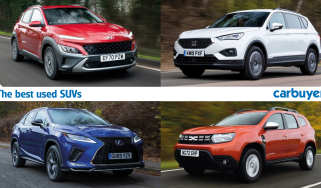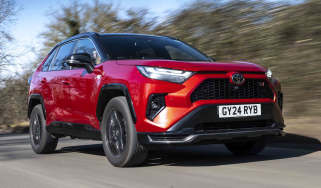Toyota RAV4 review - MPG, running costs & CO2
Low emissions make the RAV4 appealing for business and private drivers
| Pros | Cons |
|
|
Unlike quite a few of its rivals, Toyota has taken the bold decision to offer the latest RAV4 with hybrid powertrains only. That doesn’t mean it’s short of competitors, as more hybrid SUVs have been introduced – including the Hyundai Tucson, Ford Kuga and Kia Sportage, while the Honda CR-V is also only available as a hybrid.
The entry-level version – which isn’t currently offered on Toyota’s UK website – is described by Toyota as a 'self-charging hybrid', because it harvests the energy normally lost as you drive from deceleration and braking into a small battery. It doesn't have enough capacity to propel the RAV4 alone for any considerable distance but it means you’ll never need to charge it up by plugging it in. It’s technology that has been honed by cars like the Toyota Prius.
Toyota RAV4 MPG & CO2
It’s still impressively efficient for an SUV, which is all the more surprising given its large 2.5-litre petrol engine. Thanks to the boost from its electric motor, fuel efficiency is rated at up to 50.4mpg for the front-wheel drive model, with the all-wheel drive car capable of around 48.7mpg – figures that put the Honda CR-V in the shade. They emit from 129-131g/km, which isn’t bad for an SUV, but will still cost quite a bit in VED in the first year and from years two to six for versions costing over £40k to buy.
 Hyundai Tucson vs Ford Kuga vs Toyota RAV4: which should you buy?
Hyundai Tucson vs Ford Kuga vs Toyota RAV4: which should you buy?
During our test with the front-wheel drive RAV4 Hybrid, we achieved just over 47mpg from a mixture of town and motorway driving. When driving in town traffic, we found that careful use of the accelerator makes it easy to maximise the car’s pure-electric running, achieving around 40mpg when the petrol engine was used too.
More reviews
The PHEV is equipped with a much larger 18.1kWh battery, which means it can be driven for up to 46 miles without the petrol engine. When it first launched, most of its rivals had smaller batteries and smaller range figures of 30-35 miles, but this is no longer the case – the Volkswagen Tiguan eHybrid has a range of up to 77 miles. We found that 40 miles of range was possible from a full charge, even in winter.
Recharging takes around 7.5 hours using a three-pin plug, which reduces to 2.5 hours when a 7kW home wallbox is available. Its electric range helps it achieve official figures of up to 282.4mpg and 22g/km of CO2, making it cheaper to run for company-car drivers thanks to its low BiK band. In real-world driving over a mixture of conditions (but mostly urban driving) we averaged 64.7mpg.
Insurance groups
The lowest-spec Design trim with the hybrid engine sits in group 26 out of 50, which is a little higher than some rivals like the Nissan Qashqai. The GR Sport sits at the top of the range in group 32 for the hybrid and 37 for the PHEV.
Warranty
Toyota’s previous five-year warranty was pretty good, but in 2021 it announced a new ‘Relax’ warranty package. Now, you get up to 10 years’ or 100,000 miles of cover, as long as you keep having your car serviced at a main dealership. That’s a usual stipulation of carmakers’ warranty offers, but Toyota’s lengthened warranty also affects used cars too. Older cars, so long as they meet the above criteria, can get a year’s top-up warranty cover after a main-dealer service.
Servicing
Toyota offers service plans to keep your RAV4 maintained without huge bills. Your dealer will be able to advise you on how much it’ll cost per month.













